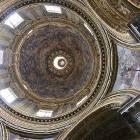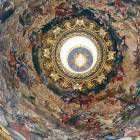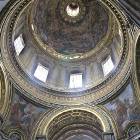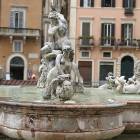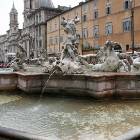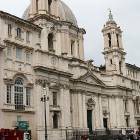Piazza Navona, with the Fountain of Neptune and Saint Agnes of Rome Church
Part of the beauty of Rome is that every street corner can turn into a museum. The public squares are places that unite locals and tourists, remembering the rich history of the city. For example, Plaza Navona, is not the most famous, nor the most romantic, but is very representative for what Rome is.
Predictably, the story starts with the age of the Empire, when here was an arena for races. As Romans were competitive and active people, they enjoyed an array of competitions, from gladiator games, to chariot races, naval battles or wrestling. Athletics were probably copied after Greek Olympics, and so was the architecture of the corresponding arena. Domitian, the youngest of the two sons of emperor Vespasian, built on this spot an arena for athletics, with a track that can still be recognized in the shape of Plaza Navona.
The arena used to have high stands, like the Colosseum, made of bricks and covered with marble, that could accommodate as many as 20.000 spectators. It’s quite easy for us to imagine the stands, as the buildings around the track maintain the shape of Domitian arena. As it happened with many ancient public buildings, after the city went into decay, it was dismantled gradually by regular people who took the needed materials. The Latin name of Domitian’s arena was Circus Agonalis, so the current name, Navona, is just a corruption of agona (compete).
During the pagan emperors, sports competitions were dirtier than we like to imagine athletics today. The example of the gladiator games, that included the killing of many Christians by wild beasts, is infamous. And such games also took place here, when the Colosseum, the great work of Vespasian royal family, was unavailable. The rooms under the arcades of this stadium were regularly used for prostitution, which was an important source of income for the infamous unbalanced budget during Vespasian and his sons.
And it was right on this place of perdition, that happened the martyrdom of Saint Agnes, a virgin killed for her Christian faith. The basilica dedicated to her marks exactly the spot where the 12 year old of noble origin was killed. She had been brought to one of the brothels inside the stadium as the Roman law exempted virgins from death penalty, but after divine intervention she remained pure before receiving the crown of martyrdom, under Diocletian.
The church of St Agnes respects the lines of Baroque architecture. Famous architects and sculptors were involved in this 17 century project: Girolamo Rainaldi, Francesco Borromini and Gianlorenzo Bernini. The main dome has a laborious fresco painted by Ciro Feri, Sebastiano Corbelini and Giovanni Batista Gauli, representing the Assumption of Mary. In the main altar, there is a bass-relief in marble, presenting the martyrdom of Saint Agnes, framed by green marble columns.
The Renaissance faded the harsh memories of the Roman age, and characters from pagan mythology were reinterpreted for esthetic purpose. Such is the case with the fountains in Plaza Navona and in other public places in the city. The Fountain of Neptune is the most expressive monument in this square, but in the 17 century, when it was built, used to have a practical purpose, as an end to an aqueduct. In the basin designed by Giacomo Della Porta and Bernini, some fine statues were added in the 19 century. The fighting Neptune is the work of Antonio Della Bitta, while the horses that seem to emerge from the waters, carrying Tritons, are the work of Gregorio Zappala.
Very close to the fountain of Neptune, is another fountain, that was meant to represent the same character, accompanied by the same mythological creatures, that were patrons of various types of water. But due to a representation of Neptune in a less European style, the fountain became known as the Fontana del Moro (The fountain of the Moor).
Standing out from the other two fountains is the Fountains of the Four Rivers (Fontana dei Quattro Fiumi), because of the high Egyptian obelisk. The work of Gian Lorenzo Bernini is just one of the numerous public fountains in Rome that resume the myth of the Roman god of sea, like is the case with the more famous Fontana di Trevi or the allegorical representations of rivers, as can be seen in the fountains in front of Vittoriano.
Mai multe despre: Italia • Ancient Rome • baroque architecture • Circus Agonalis • Emperor Domitian • Italy • Plaza Navona • Rome • St Agnes- Home Page
start page - Architecture
landmark buildings - Sacred architecture
places of worship - Nature
landscape photography - Concert
performing artists - Christmas
Santa Claus pictures
- Jooble
jobs for photographers - Escape
an out of control blog - Merry Christmas
The best organizer of Christmas parties - Astro photo
Eclipse hunting and astrological photography



